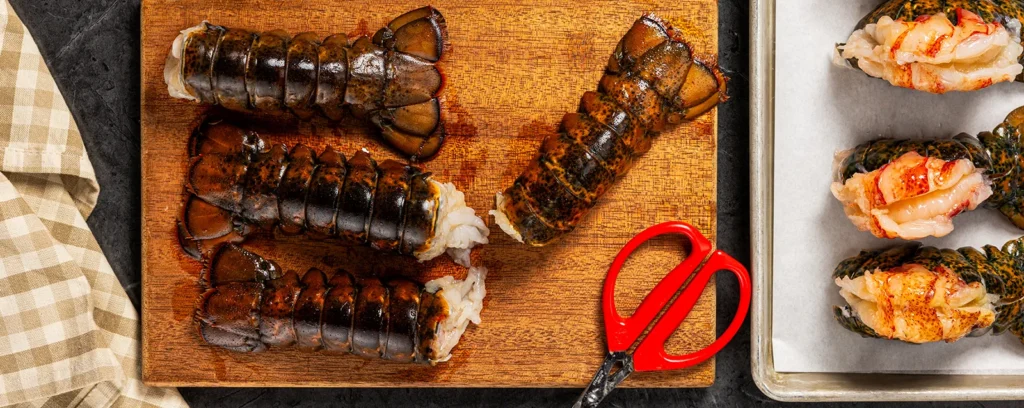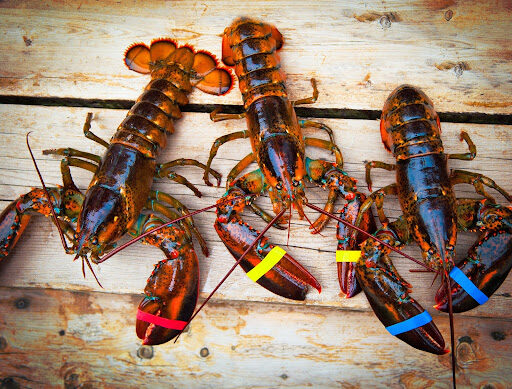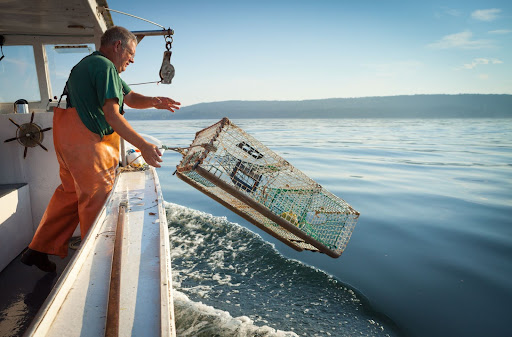
Equipment Needed for Lobster Fishing
Catching lobster requires specific gear that is designed for particular purposes. Of course, catching lobster is the primary goal, but mitigating impacts on the environment, maintaining safety for fishermen, and supporting the lobster population are also important considerations that have impacted the design and function of lobster gear. There are also rules and regulations that lobstermen must follow.
Lobster Traps
These look kind of like cages and you’ll often find them on wharves and in dooryards in coastal Maine communities. A traditional lobster trap (sometimes called a lobster pot) is the equipment primarily used for lobster fishing and the only legal way to fish for lobsters in Maine. (Diving for lobsters is common in places like Florida, but illegal in the state of Maine.)
A typical lobster trap weighs around 40 lbs. but they can get heavier than that depending on how they are constructed. Most are made with coated heavy wire, mesh, hoops, cleats, vents, weights, and runners. The wire is manipulated using a “bender” and many of the mesh and heads are affixed using hog rings.
Lobsters enter through the net head to reach the bait, set in the compartment with a fitting name, the kitchen. If a lobster attempts to escape, it will end up in another compartment, the bedroom. Lobsters remain in the bedroom until a fisherman retrieves the trap.
Maine lobster traps must have an escape vent that is small enough for legal-size lobsters to remain trapped but large enough to allow smaller lobsters to escape. Lobster traps are somewhat inefficient – but this is by design to ensure there are plenty of lobsters left in the ocean to breed and catch in the future.
Legal lobster traps must also have runners that assist with hauling the trap over the side of the boat but that also help prevent lobster claws from being caught between the bottom of the trap and the boat as the traps are hauled.
Lobster traps can cost anywhere from $130-200! With a single lobsterman owning up to 800 traps, this alone can be an enormous expense. Sometimes a lobsterman will buy a “kit” and construct the traps themselves, or sometimes they will buy fully completed lobster traps that a trap shop or marine store built. Lobstermen also sell “secondhand” lobster traps to friends and younger fishermen that are just getting started.
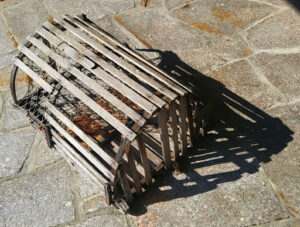
Traditional lobster traps were wood until the mid-1970s, when the transition to wire traps began. The maintenance on a coated wire trap is a fraction of what was required for their wooden ancestors, and they are far less likely to be damaged in rough seas. When wet, the wooden traps could weigh up to 125 pounds, so the change has also made back-breaking work slightly less so.
Are lobster traps ever lost at sea?
Unfortunately, rough weather can cause traps to become disconnected from their buoys or the traps can be dragged by rough tides and currents. This is not ideal, because lobster traps are expensive and replacing them can be time consuming. Lobstermen work diligently to ensure the proper care of their gear so that they can catch a lot of lobsters and ensure that their business remains profitable.
When traps are lost, they are referred to as ghost gear. But the good news is that the vents mentioned above are attached using material that will decompose over time to create a bigger hole that allows all lobster and other species to escape if traps are lost at sea. Sometimes lost traps can become like an artificial reef creating habitat and sanctuary for marine species.
The Buoys
Buoys are floating devices to mark the exact location where a fisherman has set their gear. There are usually two buoys per string of traps. A string of traps can be anywhere from two or three traps (usually inshore) and up to 20-25 traps (usually further offshore).
Buoys are often made of styrofoam or plastic, both preferred for their buoyancy and durability. Buoys that are offshore are sometimes made of different material and larger to ensure that they can be seen and hold on to the gear below.

When applying for a license to fish lobsters, a fisherman must describe their buoy colors and have at least one prominently displayed on their boat – usually a display buoy is affixed to the roof of the boat. Lobstermen can change their buoy colors but they must notify the Department of Marine Resources. This is not common because many lobstermen have maintained their buoy colors since they were young and first began fishing, and sometimes buoy colors and patterns are the same as what their father or grandfather used so they can be meaningful to a lobsterman. Most often they are only one or two colors, but some have dots, stripes, and multiple colors
Bait bag
A typical bait bag consists of nylon mesh and hangs from a line in the lobster trap. Fishermen cut up bait to stuff in the bag and it hangs in the trap to attract lobsters.
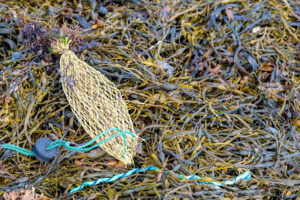
Bait
Bait is arguably one of the most essential components of optimal lobster fishing. And you might be wondering: what is the best bait to catch Maine lobsters? Many lobster fishermen have strategies, superstitions, and trade secret bait recipes consisting of things like herring (the “gold standard”), menhaden, tuna heads, monkfish heads, skate wings, and racks. Racks are the bones and meat leftover after a fish has been fileted.
Gaff Hook
A gaff is a long stick with a hook affixed to it that is used to grab a line or buoy in the water. The lobsterman will then pull the buoy and rope into the boat and around the hauler.

Hauler
Once upon a time, lobstermen pulled their heavy traps aboard by hand. Thankfully, today lobstermen use haulers that make hauling traps easier and put less wear and tear on their bodies! A hauler is a hydraulic mechanism that lobstermen use to pull their traps out of the water. Haulers are mounted on the bulkhead near the steering wheel so lobstermen are close to their wheel, throttle, and gear controls while working, because boats often have to be maneuvered while hauling gear to the surface. If a hauler is on the starboard side of the boat, it is considered “right-handed” and if it is on the port side of the boat, the boat is considered “left-handed.”
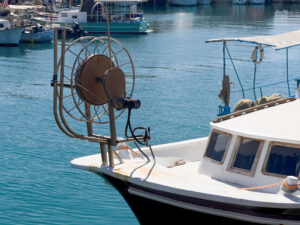
Banding Tool or Bander
The banding tool is similar to a pair of pliers and is used to put rubber bands on the lobster’s claws.
The bands immobilize the claws to protect the lobsters from each other in the holding tanks. These bands also protect the fishermen, dock workers, and restaurant employees handling them. A lobster’s crusher claw is called that for a reason: they can exert up to 100 lbs of pressure per square inch! All the more reason bands are important.
It’s recommended that when you’re cooking lobsters at home to leave the bands on until after they are cooked so you don’t get pinched! Once upon a time the bands were made of rubber and could saturate the lobster meat with a rubber flavor. Today, like so many things, these bands are made with mostly plastic and we don’t have to worry about any flavor saturating the lobster while it cooks.
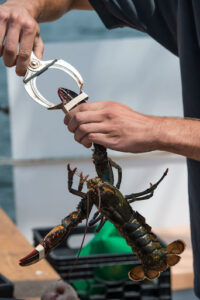
Gauge or Measuring tool
A lobster gauge measures the size of a lobster to determine if a lobster falls between the minimum and maximum size regulations for a legal catch.
One end of the gauge is hooked behind the lobster’s eye socket and the other is set at the end of his carapace or main shell where it meets the tail. In Maine, lobsters that are too small and those that are too large are returned to the sea.
Many other fisheries do not have a large-size restriction. Maine fishermen recognize that larger lobsters, both male and female, make up a significant part of the breeding population; for that reason, they are protected in Maine.
You can also find jewelry in Maine that is shaped like a lobster gauge including bracelets and rings, and necklaces that have small lobster gauge charms.
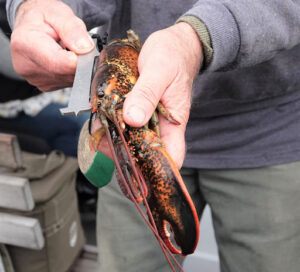
V-Notch Tool
This tool is essentially a hole punch and is used to mark a female lobster caught with visible eggs. Many lobstermen also use the small v at the bottom of a lobster measure (see above) to tear a small v in the second flipper from the right of the lobster tail. This does not harm the lobster and allows her to continue to breed as long as possible. If she is caught again, with or without eggs, but still has a v-notch, the lobsterman must throw her back. Bringing a lobster to shore with a v in her tail, or with eggs in her tail, can result in a hefty fine.
Heavy-Duty Gloves
A good pair of heavy gloves offer protection from the frigid water and wind and spare lobster fishermen from pain when handling lobsters and the fierce toothsome of spiny fish that end up in traps as bycatch.
There are two options for gloves – rubber and cotton. Cotton is more traditional and rubber is more modern. Often captains wear cloth gloves while sternmen wear rubber. Cotton grips rope better and many captains prefer it for this reason since they are the ones to clear gear when rope under strain, and sternmen prefer rubber since they are the ones who handle bait.
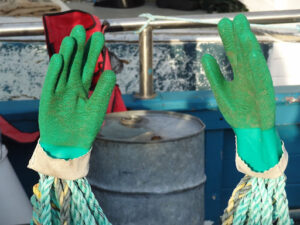
Spending Money Close to Home
Lobster gear can get expensive, and Maine lobstermen tend to spend their money close to home. Local trap companies and marine stores help supply fishermen with all their gear needs, and being able to buy stuff close to home allows lobstermen to support their local economy. This is another reason why the lobster industry is so important in Maine. The right gear helps sustain the lobster population and the Maine economy!

